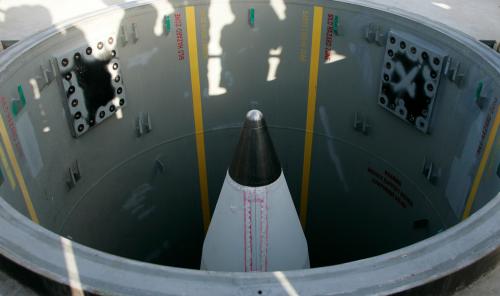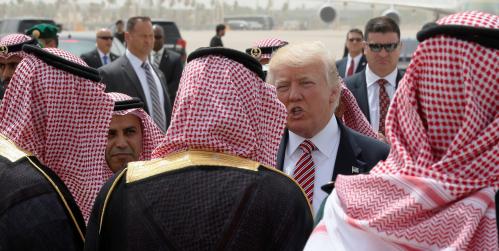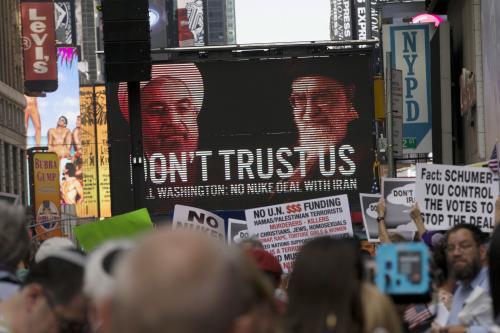In May, President Trump announced that the United States was withdrawing from the Joint Comprehensive Plan of Action (JCPOA) with Iran. One of the key reasons he cited was that the JCPOA did not address Iran’s continuing development and deployment of ballistic missiles.
Many experts, including myself (and several of my Brookings colleagues), disagreed with the Trump administration’s decision to withdraw from the JCPOA. However, most agree that Iran’s ballistic missiles represent a serious threat to the security of U.S. deployed forces and partners in the region and need to be addressed. Unfortunately, since taking office in January 2017, the Trump administration has done very little to advance one of the best options available for addressing the Iranian ballistic missile threat: enhancing multilateral missile defense cooperation with the Gulf states.
The GCC states and missile defense
One of the key lessons that the United States and the Gulf states learned from the first Gulf War in 1991 was the importance of developing effective ballistic missile defense capabilities. This was driven by Iraq’s ballistic missile attacks on Saudi Arabia and Bahrain. Since the 1990s, every Gulf state, with the exception of Oman, has purchased missile defense capabilities. For example, Saudi Arabia, Bahrain, Kuwait, Qatar, and the United Arab Emirates all possess Patriot PAC-2 and PAC-3 missile defense systems. Additionally, Saudi Arabia and the United Arab Emirates have purchased the Terminal High Altitude Area Defense (THAAD) system. Indeed, the Gulf states possess some of the world’s most advanced missile defense capabilities. That said, one major problem remains: There has been very little integration of these various national systems. While there are some technical challenges standing in the way of greater missile defense integration among the Gulf states, the primary problem is political.
Previous steps to enhance missile defense integration with the Gulf states
The United States had long understood the need to promote greater missile defense integration with the Gulf states, especially through the multilateral Gulf Cooperation Council (GCC). The rationale for greater integration is simple: By sharing radar data and other information, we can improve the probability of intercepting ballistic missile and enabling a more efficient use of limited interceptors and minimizing waste—that is, firing more than the necessary number of interceptors at a threat missile.
However, prior to 2012, little political effort had been expended to advance more robust forms of multilateral cooperation in the region. This began to change with the inaugural meeting of the U.S.-Gulf Security Forum, held in Riyadh, Saudi Arabia on March 31, 2012. At the forum, U.S. Secretary of State Hillary Clinton noted the “rock-solid commitment of the United States to the people and nations of the Gulf,” and that “furthering ballistic missile defense for the region” was a key priority. At the Manama dialogue in Bahrain the following year, U.S. Secretary of Defense Chuck Hagel echoed Clinton’s call for increased missile defense integration. Hagel stated:
“DoD will work with the GCC on better integration of its members’ missile defense capabilities. We applaud the efforts of many Gulf states to acquire new and enhanced missile defense capabilities in the face of the growing regional missile threat. But the United States continues to believe that a multilateral framework is the best way to develop interoperable and integrated regional missile defense.”
With that senior-level guidance from the secretaries of defense and state, the U.S. government launched a major interagency effort to improve missile defense integration with the GCC states. These efforts culminated at the Camp David Summit on May 14, 2015. At the summit, GCC members announced their commitment “to develop a region-wide ballistic missile capability, including through the development of a ballistic missile warning system” and to participate in a “senior leader tabletop exercise to examine improved regional ballistic missile defense cooperation.”
These summit missile defense commitments were largely completed by the fall of 2016. The senior leadership tabletop exercise, which brought together officials and military officers, was held in Kuwait in April 2016, and the ballistic missile early warning study was completed and provided to the GCC in August 2016. The United States had also designated the GCC eligible to make multilateral purchases through the U.S. Foreign Military Sales program. Therefore, by the end of the Obama administration, all the necessary building blocks were in place to achieve greater missile defense integration with the GCC.
Dropping the ball?
Since assuming office in January 2017, enhancing multilateral missile defense integration with the Gulf states does not appear to be a major priority for the Trump administration. At the U.S.-GCC summit, held in Riyadh on May 21, 2017, U.S. and GCC leaders instructed senior officials to “ensure the continuity” and “accelerate implementation of decisions contained in the joint statement of the second Gulf-American Summit on April 21, 2016,” to include work on missile defense. However, beyond the summit language, it does not seem as though much, if any, additional progress has been made. From the sidelines of the summit, the Trump administration did announce a $110 billion weapons sale to Saudi Arabia, which included several THAAD missile defense systems—many of those systems had already been in the pipeline under the Obama administration.
So why have efforts to move toward greater missile defense integration with the GCC failed? Saudi Arabia and UAE’s dispute with, and subsequent blockade of, Qatar seems to be a key impediment to progress. Expressing his frustration with the situation in January 2018, Secretary of Defense James Mattis stated: “A united Gulf Cooperation Council bolsters our effectiveness on many fronts, particularly on counterterrorism, defeating ISIS Daesh, and countering the spread of Iran’s malign influence.” According to press reports, U.S.-led efforts are seeking to resolve the rift between GCC states with the objective of holding a U.S.-GCC summit in Washington this September, though it is uncertain whether the summit will actually take place.
The U.S. Congress recently weighed in on the issue. In its version of the Fiscal Year 2019 National Defense Authorization Act, the House Armed Services Committee expressed its desire to see a resumption of GCC missile defense integration. Section 1224 of the legislation calls on GCC member states to “take meaningful steps to develop and implement an interoperable ballistic missile architecture to defend against Iran’s ballistic missile threat that emphasizes information sharing and includes early warning and tracking data.”
The way ahead
Given the Trump administration’s concerns regarding the ballistic missile threat from Iran, it’s disappointing that it has not focused more attention on advancing effective integration with the Gulf states. That said, there are a number of steps that the administration could take to get the process back on track.
First, the senior political leadership in the United States—at the White House, as well as State and Defense departments—need to express their vocal support for increased U.S.-GCC missile defense cooperation. Second, the upcoming U.S. Missile Defense Review should highlight multilateral missile defense cooperation in the Gulf as a high priority. Third, a key objective at the next U.S.-GCC summit, which could be held in September, should be to advance greater missile defense integration. Fourth, sustained engagement by senior-level U.S. officials with the GCC member states and the GCC Secretariat will be critical to successful implementation.
And finally, if the other Gulf states fail to reach an overall political settlement with Qatar within the framework of the GCC, then the United States should move forward with multilateral cooperation in the Gulf without Qatar. While it is highly desirable to include Qatar in any multilateral missile defense architecture in the Gulf, especially given the ballistic early warning radar it is procuring, its participation is not essential to enabling greater integration.
If the administration is serious about confronting the Iranian ballistic missile threat, no time should be wasted in capitalizing on previous steps taken to secure multilateral missile defense cooperation among the Gulf states. Taking the aforementioned steps would not only help protect U.S. interests in the region, but also enhance the security of our Gulf partners.
The Brookings Institution is committed to quality, independence, and impact.
We are supported by a diverse array of funders. In line with our values and policies, each Brookings publication represents the sole views of its author(s).











Commentary
If Trump is serious about addressing the Iranian ballistic missile threat, he should enhance multilateral missile defense cooperation with Gulf states
June 20, 2018